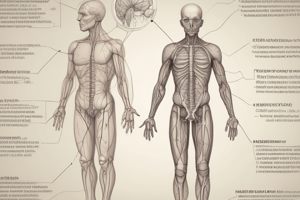Podcast
Questions and Answers
Which type of nerve fibers transmit acute, sharp pain at a rapid rate?
Which type of nerve fibers transmit acute, sharp pain at a rapid rate?
- Efferent fibers
- C fibers
- A-Delta fibers (correct)
- Nociceptors
According to the provided content, which of the following best describes the function of efferent nerve fibers?
According to the provided content, which of the following best describes the function of efferent nerve fibers?
- They are responsible for the sensation of touch and temperature.
- They send signals from the peripheral sensory receptors to the spinal cord and brain.
- They carry impulses from the Central Nervous System (CNS) to other parts of the body. (correct)
- They transmit pain impulses to the brain.
Which theory proposes that pain results from excessive stimulation of sensory receptors?
Which theory proposes that pain results from excessive stimulation of sensory receptors?
- Pattern theory
- Specificity theory
- Intensity theory (correct)
- Gate control theory
According to the provided text, which of the following is NOT identified as a factor affecting an individual's response to pain?
According to the provided text, which of the following is NOT identified as a factor affecting an individual's response to pain?
Which of the following describes the role of the 'gate' in pain management, according to the gate control theory?
Which of the following describes the role of the 'gate' in pain management, according to the gate control theory?
Which of the following best describes referred pain?
Which of the following best describes referred pain?
What is the primary role of Nociceptors in pain perception?
What is the primary role of Nociceptors in pain perception?
What is the primary role of afferent nerve fibers in the context of pain transmission?
What is the primary role of afferent nerve fibers in the context of pain transmission?
Which of the following best describes the pattern theory of pain?
Which of the following best describes the pattern theory of pain?
What is the role of the reticular activating system in the pain pathway?
What is the role of the reticular activating system in the pain pathway?
According to the gate control theory, which factors influence the opening or closing of the ‘gate’?
According to the gate control theory, which factors influence the opening or closing of the ‘gate’?
Which phase of pain transmission involves the conscious awareness of pain?
Which phase of pain transmission involves the conscious awareness of pain?
During the modulation phase of pain impulse transmission, what is the direction of interaction?
During the modulation phase of pain impulse transmission, what is the direction of interaction?
Which of the following is NOT a function of the autonomic nervous system?
Which of the following is NOT a function of the autonomic nervous system?
Which neurotransmitter is primarily associated with the sympathetic nervous system's fight-or-flight response?
Which neurotransmitter is primarily associated with the sympathetic nervous system's fight-or-flight response?
What is the main function of the spinal cord regarding pain?
What is the main function of the spinal cord regarding pain?
Which factor most significantly influences the variation in a patient's surgical experience?
Which factor most significantly influences the variation in a patient's surgical experience?
What is the primary responsibility of the circulating nurse during a surgical procedure?
What is the primary responsibility of the circulating nurse during a surgical procedure?
What would happen if the circulating nurse finds that patient consent was not obtained prior to surgery?
What would happen if the circulating nurse finds that patient consent was not obtained prior to surgery?
Who is responsible for labeling tissue specimens obtained during surgery?
Who is responsible for labeling tissue specimens obtained during surgery?
What is the purpose of the sponge count in surgery?
What is the purpose of the sponge count in surgery?
Who is the head of the surgical team and performs the surgical procedure?
Who is the head of the surgical team and performs the surgical procedure?
Under whose direct supervision does the Registered Nurse First Assistant practice?
Under whose direct supervision does the Registered Nurse First Assistant practice?
When do sponge counts occur at the end of a procedure?
When do sponge counts occur at the end of a procedure?
What is the primary purpose of placing a patient in a lateral position with neck extension in the immediate post-anesthesia recovery phase?
What is the primary purpose of placing a patient in a lateral position with neck extension in the immediate post-anesthesia recovery phase?
Which of the following is NOT a typical characteristic of the Post-Anesthesia Care Unit (PACU)?
Which of the following is NOT a typical characteristic of the Post-Anesthesia Care Unit (PACU)?
A patient in the PACU has developed atelectasis, what does this mean?
A patient in the PACU has developed atelectasis, what does this mean?
Which of these is NOT a common respiratory complication observed in the PACU?
Which of these is NOT a common respiratory complication observed in the PACU?
During which phase of post-anesthesia care is the patient primarily prepared for self-care or care in an extended care setting?
During which phase of post-anesthesia care is the patient primarily prepared for self-care or care in an extended care setting?
Which of the following is a primary reason for applying a post-operative dressing?
Which of the following is a primary reason for applying a post-operative dressing?
Which intervention is NOT typically performed by nursing staff to help maintain cardiovascular stability in a PACU patient?
Which intervention is NOT typically performed by nursing staff to help maintain cardiovascular stability in a PACU patient?
Hypotension, shock, and dysrhythmias are all examples of what type of complications?
Hypotension, shock, and dysrhythmias are all examples of what type of complications?
A patient in the PACU has several contraptions attached, which one is most important for short-term airway management?
A patient in the PACU has several contraptions attached, which one is most important for short-term airway management?
What is the first nursing intervention immediately following a patient's transfer to the PACU?
What is the first nursing intervention immediately following a patient's transfer to the PACU?
What is the primary reason for monitoring a patient's temperature hourly in the PACU?
What is the primary reason for monitoring a patient's temperature hourly in the PACU?
What action should a nurse take if a patient in the PACU exhibits a temperature of 38.0°C (100.4°F)?
What action should a nurse take if a patient in the PACU exhibits a temperature of 38.0°C (100.4°F)?
Post-anesthesia shivering (PAS) is MOST likely to occur in which of the following situations?
Post-anesthesia shivering (PAS) is MOST likely to occur in which of the following situations?
Which of the following is a priority intervention related to maintaining adequate fluid volume in the PACU?
Which of the following is a priority intervention related to maintaining adequate fluid volume in the PACU?
What assessment would provide the BEST indication of potential fluid imbalance outside of lab values?
What assessment would provide the BEST indication of potential fluid imbalance outside of lab values?
Why is it critical to check dressings for constriction in the PACU?
Why is it critical to check dressings for constriction in the PACU?
What is the primary reason for keeping side rails up for a patient in the PACU?
What is the primary reason for keeping side rails up for a patient in the PACU?
What action should a nurse prioritize regarding IV lines in the PACU?
What action should a nurse prioritize regarding IV lines in the PACU?
Flashcards
Pain
Pain
An unpleasant sensory and emotional experience associated with actual or potential tissue damage, described in terms of such damage.
Pain Threshold
Pain Threshold
The level of pain that someone experiences.
Pain Tolerance
Pain Tolerance
The amount of pain a person can tolerate before needing to take action.
Decreased Pain Tolerance
Decreased Pain Tolerance
Signup and view all the flashcards
Increased Pain Tolerance
Increased Pain Tolerance
Signup and view all the flashcards
Pain Perception
Pain Perception
Signup and view all the flashcards
Pharmacological Pain Management
Pharmacological Pain Management
Signup and view all the flashcards
Non-pharmacological Pain Management
Non-pharmacological Pain Management
Signup and view all the flashcards
Visceral Pain
Visceral Pain
Signup and view all the flashcards
Pain Transmission
Pain Transmission
Signup and view all the flashcards
Afferent Nerve Fibers
Afferent Nerve Fibers
Signup and view all the flashcards
Spinal Cord Network
Spinal Cord Network
Signup and view all the flashcards
Pain Modulation
Pain Modulation
Signup and view all the flashcards
Autonomic Nervous System
Autonomic Nervous System
Signup and view all the flashcards
Sympathetic Nervous System
Sympathetic Nervous System
Signup and view all the flashcards
Nociceptors
Nociceptors
Signup and view all the flashcards
CNS
CNS
Signup and view all the flashcards
Intensity Theory of Pain
Intensity Theory of Pain
Signup and view all the flashcards
Pattern Theory of Pain
Pattern Theory of Pain
Signup and view all the flashcards
Specificity Theory of Pain
Specificity Theory of Pain
Signup and view all the flashcards
Brain's role in pain
Brain's role in pain
Signup and view all the flashcards
Circulating Nurse's Role
Circulating Nurse's Role
Signup and view all the flashcards
Circulating Nurse's Responsibilities
Circulating Nurse's Responsibilities
Signup and view all the flashcards
Consent Verification
Consent Verification
Signup and view all the flashcards
Resource Management
Resource Management
Signup and view all the flashcards
Surgeon's Role
Surgeon's Role
Signup and view all the flashcards
Surgeon's Qualifications
Surgeon's Qualifications
Signup and view all the flashcards
RN First Assistant
RN First Assistant
Signup and view all the flashcards
Sponge Counts
Sponge Counts
Signup and view all the flashcards
Phase 1 of PACU
Phase 1 of PACU
Signup and view all the flashcards
Phase 2 of PACU
Phase 2 of PACU
Signup and view all the flashcards
Phase 3 of PACU
Phase 3 of PACU
Signup and view all the flashcards
Atelectasis
Atelectasis
Signup and view all the flashcards
Pneumonia
Pneumonia
Signup and view all the flashcards
Hypostatic Pulmonary Congestion
Hypostatic Pulmonary Congestion
Signup and view all the flashcards
Hypotension
Hypotension
Signup and view all the flashcards
Shock
Shock
Signup and view all the flashcards
Hypertension
Hypertension
Signup and view all the flashcards
Dysrhythmias
Dysrhythmias
Signup and view all the flashcards
Malignant Hyperthermia
Malignant Hyperthermia
Signup and view all the flashcards
Hypothermia
Hypothermia
Signup and view all the flashcards
Post Anesthesia Shivering (PAS)
Post Anesthesia Shivering (PAS)
Signup and view all the flashcards
Intake and Output (I&O)
Intake and Output (I&O)
Signup and view all the flashcards
Central Venous Pressure (CVP)
Central Venous Pressure (CVP)
Signup and view all the flashcards
Electrocardiogram (ECG or EKG)
Electrocardiogram (ECG or EKG)
Signup and view all the flashcards
Tidal Volume
Tidal Volume
Signup and view all the flashcards
Thermoregulation
Thermoregulation
Signup and view all the flashcards
Study Notes
Pain Management
- Pain is defined as an unpleasant sensory and emotional experience associated with actual or potential tissue damage.
- Pain can be mild, moderate, or severe.
- Adults and children perceive pain differently.
- Infants (1 to 2 days old) are less sensitive to pain compared to children (3-12 months old).
- Pain threshold is the level at which a person experiences pain.
- Pain tolerance is the maximum intensity or duration of pain a person is willing to endure.
- Pain tolerance varies greatly among individuals and can change over time.
- Elderly individuals generally have lower pain tolerance.
- Women, generally, appear to be more tolerant to pain than men.
Pain Tolerance
- Pain tolerance declines with repeated exposure to pain, fatigue, anxiety, boredom, and apprehension.
- Pain tolerance increases with factors like alcohol consumption, medications, hypnosis, warmth, or distracting activities.
- The client, not a physician or nurse, is the best judge of pain level and distress.
- Pain is not a direct result of aging.
Pain Management
- Pain management can involve pharmacological, non-pharmacological, or surgical approaches.
- Surgical options are considered a last resort.
- Pharmacological methods include medications.
- Non-pharmacological methods include relaxation techniques, distraction, and physical therapy.
Pain Perception
- The conscious experience of discomfort is pain perception.
- Children and adults differ substantially in the way they perceive pain.
- Infants (1 to 2 days old) display less sensitivity to pain, and pain becomes evident in (3–12 months old)
- Infants (1-2 days old) less sensitive to pain as compared to (3-12 months)
Myths about Pain
- Myth 1: The nurse or physician is the best judge of a client's pain.
- Fact 1: Only the client can determine the level and distress of the pain.
- Myth 2: Pain is a part of aging.
- Fact 2: Pain itself does not accompany aging unless an illness or disease is present.
- Myth 3: If a person is asleep, they aren't experiencing pain.
- Fact 3: Pain management should involve a team approach.
- Myth 4: Pain is a result, not a cause of the ailment.
- Fact 4: Pain is present in the presence of an illness or disease.
- Myth 5: Real pain has an identifiable cause.
- Fact 5: Pain may be caused by an obscure reason.
- Myth 6: Young or very old people do not experience pain.
- Fact 6: Pain is universal regardless of age and can occur in people at different stages of life.
Types of Pain
- Nociceptive pain: most common type that is caused by potentially harmful stimuli.
- Somatic pain: caused by injury to skin, muscles, bone; joint, and connective tissues.
- Superficial somatic pain: sharp or burning discomfort.
- Deep somatic pain: dull or aching diffuse discomfort.
- Visceral pain: originates from injury, ongoing injury to internal organs and tissues.
- Neuropathic pain: symptom/complication of diseases, conditions involving pain pathways in peripheral or central nervous system.
- Psychogenic Pain: psychological problems and not from physical cause.
Pain Theories
- Intensity Theory: Pain is a result of excessive sensory stimulation.
- Pattern Theory: Painful and non-painful sensations are transmitted using nonspecific pathways.
- Specificity Theory: Emphasizes four cutaneous sensations: touch, temperature, and pain.
- Gate-Control Theory: Pain impulses from touch receptors to spinal cord influence pain perception.
Pain Control Theories
- Intensity Theory: Pain results from excessive sensory stimulation.
- Pattern Theory: Painful and non-painful sensations use a general pathway.
- Specificity theory: Explains four distinct cutaneous sensations: touch, temperature, pain.
- Gate Control Theory: Pain impulses from skin to spinal cord and interaction with pain processing.
Pain Management Techniques
- Blocking brain perception: reducing the client's pain perception.
- Interruption of pain-transmitting chemicals at the site of injury: reducing pain by affecting the transmission of pain signals.
- Combining analgesics with adjuvant drugs: better pain relief by combining pain medication with other drugs.
- Using gate-closing mechanisms: blocking pain signal transmission at the spinal cord level using different methods.
- Altering pain transmission at the spinal cord level: enhancing the effectiveness of pain management by affecting different pain signals.
Drug Interventions
- Patient-controlled analgesia (PCA): Allows patients to self-administer analgesics.
- Opioid analgesics: Highly effective pain relief medications acting on opioid receptors in the nervous system.
- Non-opioid analgesics (NSAIDs): Effective for both acute and chronic pain because they have analgesic and anti-inflammatory properties.
- Adjuvant analgesics: Enhance the effectiveness of other pain medicines by targeting multiple pain pathways or modulating the immune response.
Studying That Suits You
Use AI to generate personalized quizzes and flashcards to suit your learning preferences.




